Secure and safe workplace and health management
At Murata, we see operating capital as a source of value creation developed by putting our philosophy into practice. We believe that people are at the core of creating value, and have defined safe and secure workplaces and health management as "engagement" items important for human capital.
With this in mind, we have defined "each employee can work while feeling that they are healthy in a safe workplace" as what Murata wants to be by 2030. All people working in Murata should be healthy with their "mind" and "body" as well as "relationship between people and society," in harmony and they should be naturally acting safely. In the workplace environment, they should be able to concentrate on their work without worries and experience few near-miss incidents.
Link: Human Rights and Labor Policies
EHS disaster prevention policy of the Murata Manufacturing Group
Murata Health Declaration
Goals
In order to create an environment in which all Murata employees can work while feeling in a safe, secure, and healthy workplace, we established the FY 2024 targets and the FY 2030 targets as described below to promote health and safety activities.
| FY 2024 targets |
- Fatal serious incidents: 0
- Incident rate per 1,000 workers*: Less than 1.35
- Fire incidents: 30% reduction compared with average for fiscal 2019-2021
- Subjective view of health: 80% (with 14% reporting extremely good health)
|
| FY 2030 targets |
No Fatal serious incidents, no employee injuries or incidents, and a vibrant workplace.
- Fatal serious incidents: 0
- Incident rate per 1,000 workers: Less than 1.0
- Fire incidents: 0
- Subjective view of health: 80% (with 20% reporting extremely good health)
|
Health and safety promotion system
Murata appoints top management members to lead health and safety activities, and our sustainability department supports and promotes health and safety activities across the business sites.
Furthermore, the Health and Safety Promotion Committee, which is an advisory body to the top management, discusses and shares the following subjects related to health management and health and safety. The concerns discussed by the Health and Safety Promotion Committee are reported to and discussed within the CSR Management Committee, and the discussions in the committee are also overseen by the Board of Directors.
-
(1)
Polices and what Murata wants to be
-
(2)
Important issues and goals
-
(3)
Policies and result reports
The Health and Safety Promotion Committee comprises the business site EHS managers and safety committee members from each site. At each site, the top supervisor is assigned as a full-time executive officer, and the work-site secretariat supports and promotes health and safety activities under the instruction of the business site EHS manager. In addition, the Safety and Health Committee holds meetings where the company and the labor union can gather and discuss employee safety and health issues in order to facilitate and ensure the implementation of health and safety activities at the business site.
As for industrial health professionals, we have 16 dedicated industrial physicians and 64 nurses.
Link: Overview of Murata’s Corporate Governance System
Creating safe and secure workplace environments
Management system
Based on the Industrial Safety and Health Act and ISO 45001 requirements, Murata established the “EHS Management System.”
In addition, considering integration with EHS and obtaining ISO certificates, we have established two unique disaster prevention management systems, in order to create safe and secure workplace environments.
Based on our EHS disaster prevention policy, these management systems are managed using the PDCA cycle along with various rules for leadership and commitment, organization roles/responsibilities and authorities, participation of workers in discussions, identifying risks and opportunities and determining evaluation/operation methods, identifying dangers, determining legal and other requirements, establishing plans for initiatives, establishing EHS targets and plans for accomplishing them, evaluations and measures based on risk assessments, resources/skills/awareness/communication, managing documented information, incident (industrial incidents, environmental incidents, fires) records and reports, operation planning and management, preparing for and responding to emergencies, monitoring/measurement/analysis/performance evaluations, compliance evaluations, internal audits, management reviews, determining opportunities for improvements, incidents/defects, corrective measures, and more.
-
P:
(1) Risk source identification, risk assessment, and new management plan determination
(2) Legal and other requirements
(3) Targets and implementation plans
-
D:
(1) Ability, educational training, and awareness
(2) Resources, roles, execution responsibility, accountability, and authority
-
C:
Internal audits
-
A:
Review by the management (management reviews)
We realize that creating networks among those in charge of individual production sites is important in operating and promoting management systems. Production site representative meetings are held periodically and information is exchanged so as to achieve targets and thereby strengthen the promotion framework.
Results (Reflecting on fiscal 2022 in order to achieve fiscal 2024 goal)
Murata has promoted safety and health activities, in order to create a workplace environment in which employees can work with a sense of safety and security.
We also believe that incidents that require time off from work and those that do not have the same root causes. The incident rate per 1,000 workers (our goal indicator) is managed for both of these kinds of incidents, in an attempt to reduce the occurrence of industrial incidents.
The incident rate per 1,000 workers (covering full-time employees, temporary employees, and permanent contract employees) for fiscal 2022 was approximately 40% lower than our peak in fiscal 2018. We will continue to promote safety and health activities in order to achieve our fiscal 2024 goal.
Annual incident rate (per 1,000 workers)*1 / Number of serious incidents
-
*1
Annual incident rate (per 1,000 workers): The ratio of the number of occupational injuries and deaths per 1,000 workers in one year.
At Murata, this rate is managed using the number of occupational injuries and deaths including both incidents that require time off from work and those that do not.
Includes: Full-time employees, temporary employees, and permanent contract employees
Refer to ESG data collection / GRI standard comparison table / SASB comparison table for other data.
< Other data >
- Lost Time Injury Frequency Rate (LTIFR)
- Number of serious incidents
- Incident rate per 1,000 workers (by employee)
- ISO45001 certification ratio
- Number of exclusive industrial physicians
Serious industrial incidents occurring in fiscal 2022, and response
There were no fatal incidents or serious industrial incidents that led to after-effects over the five-year period from fiscal 2018 to fiscal 2022.
*(Target: Employees, temporary employees, manufacturing contractors, and other permanent contractors)
We will continue efforts to prevent serious work-related incidents by implementing risk-reduction measures based on risk assessments and ensuring thorough control measures by issuing company-wide notifications and conducting in-house safety patrols.
In the event of a serious work-related incident, we will respond quickly in accordance with the following procedures to prevent similar incidents.
-
(1)
Immediately after the occurrence of an incident, the office where the incident occurred will contact the head office and provide the latest report on the incident.
-
(2)
Immediately after receiving the report, the head office will issue the latest report on the incident to management and the entire company. Depending on the nature of the incident, it may be reported to customers.
-
(3)
Within two weeks after the incident, the office where the incident occurred will inform the head office of the cause of the incident and details of measures to prevent recurrence.
-
(4)
Immediately after receiving the report, head office will communicate the cause of the incident and details of the measures to prevent recurrence to management and the entire company. Depending on the nature of the incident, management and the company will discuss measures to prevent recurrence of the incident and spread them horizontally throughout the company.
-
(5)
After the implementation of the recurrence measures is completed, the incident site and head office will hold a company-wide committee meeting attended by management to discuss the final report.
Employee health and safety
Training and awareness-raising
Murata conducts safety and health training by role and by level. We analyzed past industrial incidents and found that the majority of them were caused by new employees or otherwise unexperienced employees with insufficient skill or knowledge. We therefore also conduct risk experience training focused on enhancing employees' sensitivity to risks. We use this risk experience training to provide employees with a safe way to actually experience danger and enhance safety awareness, in order to help prevent incidents from occurring at work. Although risk experience training is mostly conducted at domestic production sites, we are also expanding this to our overseas sites. We will continue to promote this training as we make use of our sustainability investment promotion system, which is a business management system supporting initiatives for achieving our social value goals.
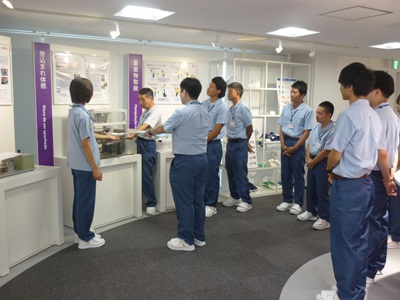 Fukui Murata Manufacturing Murata Safety (MS) Center: Experience-based danger prevention training
Fukui Murata Manufacturing Murata Safety (MS) Center: Experience-based danger prevention training
Creating a culture of safety
Murata is involved in various initiatives to create a culture of safety. We aim to establish a virtuous cycle of social value and economic value. It is for this reason that we have established a Presidential award called the "Social Value Contribution Award," which is awarded for activities recognized as having a remarkable contribution toward improving our social value or promoting ESG activity. In fiscal 2022, Murata Electronics Philippines Inc. was given this award for completely eliminating industrial incidents. In addition to reviewing our risk assessment system and introducing new risk assessments that cover more types of risks primarily in domestic sites, we have been training required personnel and engaging in safety activities on-site (such as holding the Greater China Safety Gathering) at overseas sites, in order to create a culture of safety.
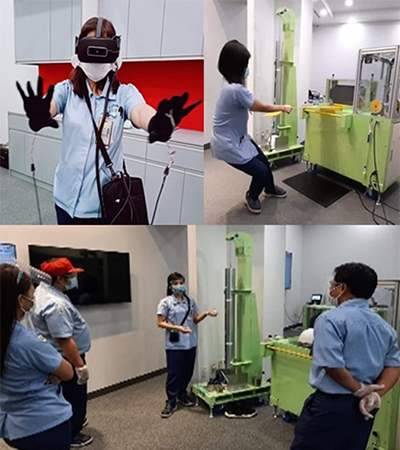 Murata Electronics Philippines Inc. MS Center, unsafe situation experience training
Murata Electronics Philippines Inc. MS Center, unsafe situation experience training
Future measures
We will continue to build systems capable of autonomously operating and managing new risk assessments (from training to implementation), develop safety and health training systems, and introduce health/safety/security evaluation systems, at each of our production sites. Through all of these efforts, we aim to further increase the safety literacy of each employee and create a culture that commends health, safety, and security, supported by "the obligation to consider safety" assumed by management and "the obligation to maintain one's health" assumed by individual employees.
Safety and health education system (image)
Health management
Murata’s management approach pertaining to the health management plan
To sincerely support our employees' health, Murata has formulated the "Murata Health Management Plan" as a medium-term guideline. The plan, formulated in fiscal 2019, was reviewed for six months in 2020. This was because the outbreak of COVID-19 drastically changed employees' awareness of their health and their workplace environments. Approximately 40 staff members who had a strong awareness of the changes gathered from 11 business sites and had discussions from different perspectives based on their own positions such as industrial physicians, health nurses and nurses, health promotion administrative staff, staff of safety functions, and members of the Health Insurance Society. At first, they reviewed the company creed and "CS/ES (the most important management values)," and then set ideal goals for the health management of Murata. Then, they analyzed the actual conditions of employees on the basis of quantitative data (including the results of medical examinations or stress checks and data on industrial incidents) and qualitative information (employees' actual conditions understood through health management work such as interviews and inspections). Finally, they identified issues and measures to address them. They then established four plans (described below) under the concept of "practical health management," and promoted initiatives to achieve goals.
The Health Management Plan is a policy for "maintaining and improving engagement," which is an important human capital issue. Shift workers are especially crucial for manufacturing at Murata, and so we have been focusing on getting workers to sleep better and focusing on enhancing stress management to help alleviate the negative impact that the rapid expansion of the company size and new working practices can cause. These initiatives will help employees to better feel meaningfulness and development.
Details of health management plans
Murata's health management strategy map
We are creating a health management strategy map to achieve specific measures, by identifying management issues to solve through health management and then setting goals to solve these issues.
See large image 
Health management promotion based on the Health Management Plan
The Health Management Plan is not promoted in response to directions or orders from headquarters or management, but is voluntarily promoted by each business site base on actual conditions. To increase effectiveness, we set up "Health Management Plan Dialog Meetings" (held four times a year) to propel the PDCA cycle. These dialog meetings are attended by industrial physicians, health nurses and nurses from 27 business sites, health promotion administrative staff, staff of safety functions, staff of human resource functions, and members of the Health Insurance Society. In each meeting, participants review company-wide topics and share and discuss actual initiatives carried out at each business site. In the "PLAN" phase, participants confirm what Murata wants to be as well as the objectives of each plan and determine important company-wide topics for the coming year as well as initiatives to be taken by each business site. Furthermore, these dialog meetings serve as an opportunity for getting inspiration for better measures (DO), reflecting on topics, and reviewing results (CHECK). On the basis of the knowledge obtained, each business site examines "ACTION" to make further improvement. Furthermore, officers in charge periodically take part in "Industrial Physicians Meetings," in which all industrial physicians in our company participate, and in "Health Staff Meetings," in which health nurses and nurses participate. The officers in charge discuss how to promote the health management at Murata with other participants. In this way, we practically apply "autonomous and distributed organizational operation" specified in Vision 2030 to the promotion of health management.
Link: Vision 2030 (long-term direction)
 Health management promotion based on the Health Management Plan
Health management promotion based on the Health Management Plan
Benefits of health management
The management issue we hope to solve through health management is "maintaining and improving engagement," which is a key issue for human capital.
We use the following indicators to determine whether employees are able to feel healthy while working in safe workplaces.
1. Outcome indicators
(1) Subjective view of health
At Murata, we define "health" not as being healthy and strong, but as a state where the body, mind, and relationship between people and society are in harmony. We therefore believe that this goes beyond whether someone is medically healthy. The employees themselves must also feel healthy. The "subjective view of health" indicator is not a numerical result from a medical examination, but is instead subjectively evaluates an individual's own state of health. We use a stress check question ("Regardless of any illnesses you might or might not have, do you feel healthy?") to score this.
(2) Presenteeism/absenteeism
"Enhancement of stress management" is listed as a key initiative in the Health Management Plan. We can create and provide value to customers (CS) by ensuring that our employees feel healthy and work at peak performance. Our goal is for employees themselves to feel meaningfulness and development (ES) through this process. At Murata, we believe that this will create "engagement." We believe that our employees are at the foundation of our company. At the same time, the environment around Murata continues to change drastically, including changes to our business environment and working practices. We will continue to promote efforts to keep employees healthy and working at peak performance. We have set presenteeism and absenteeism as indicators for these initiatives.
●1. Presenteeism
We began using presenteeism for monitoring purposes, in order to determine the level of performance of employees. We first determine the current situation, and then we convert the passing of years into a number and consider whether the level of performance is suitable for Murata.
●2. Absenteeism (ratio of employees taking leave of at least one month)
Instead of aiming for no employees taking sick leave, we focus on establishing environments where employees suffering from significantly reduced performance can easily ask for advice if they feel down either physically or mentally. By discovering these issues early on and handling them (or having employees take sick leave as soon as possible), we aim to get employees back into working shape, as quickly as possible. By discovering these issues before they become long-term problems, we continue to monitor our employees to ensure that there are no significant fluctuations in absenteeism.
2. Indicators related to awareness or behavior changes
Improvement of sleep indicator (do employees feel refreshed after sleeping? [stress check])
Quality of sleep has a significant effect on both body and mind. We are focused on improving the quality of sleep of our employees.
We visualize trends based on negative responses to a stress check item ("I do not sleep well"), for use as an initiative result indicator.
- * Requirements for obtaining data are being revised according to fiscal 2022 data updates. Due to these revisions, past data is also being recalculated.
Health management initiatives to support "maintaining and improving engagement" (an important human capital issue)
Here, we introduce Murata's initiatives in detail. We will continue to promote initiatives to establish environments in which each and every employee can work while feeling healthy.
Measures to prevent infection
Murata is doing everything possible to perform daily health management and prevent infection, in order to protect the physical and mental health of each employee, meet customers' expectations, and fulfill our social responsibilities as a parts manufacturer supporting social infrastructures.
In order to help prevent the spread of COVID-19, we managed site hygiene by preparing alcohol-based sanitizers, recommended remote work and flexible/staggered shifts, instructed sick employees to stay home (with leave compensation exceeding that designated by law), provided personnel system support to provide special paid leave when schools were closed, and held workplace vaccinations at seven sites (including headquarters) for employees and partner company employees.
In addition to implementing measures to prevent infection, we provided employees with opportunities to discuss health concerns with industrial health professionals, and held online information sessions on COVID-19 conducted by industrial physicians. We also shared materials with employees, partner company employees, and their family members, in order to help keep them healthy and safe. We also provide information on flus and encourage them to receive vaccinations each year.
Initiatives to help enhance stress management
"Enhancement of stress management" is an initiative listed in our Health Management Plan, and is taken from a viewpoint of how employees can overcome significant changes in working practices due to the popularization of remote work. In order to achieve this, we believe that it is important for individuals to "trust, cooperate, and harmonize with each other." However, we have found that new employees joining our organization are experiencing the most difficulty accomplishing this. To begin with, it is stressful for new employees to become accustomed to the new environment and develop relationships with co-workers. Accordingly, we have decided to take measures that focus on "new graduate employees," "employees recruited as experienced personnel," "employees dispatched from overseas (employees dispatched from overseas sites to Japan)," and "employees dispatched to overseas sites (employees dispatched from Japan to overseas sites)." We conduct stress management, in order for these employees to exercise their abilities and cooperate with many people.
1. Support for new graduate employees and employees recruited as experienced personnel
The popularization of remote work has dramatically changed working practices and how we communicate. We have made use of online tools to streamline work and realize diverse working practices. However, working online has revealed several issues. For example, it can take time to develop relationships at the workplace, and it can be difficult to monitor employees and determine whether they are truly feeling well. In order to address these issues, we are working on initiatives to enhance stress management, targeting those employees most easily affected: new graduate employees and employees recruited as experienced personnel.
One specific initiative is training conducted to help new employees understand the importance of learning how to cope with stress and consulting with others when feeling anxious. We use this to provide opportunities to learn self-care methods and other measures, through group work. Since we confirmed the effects through questionnaires concerning the training program and follow-up interviews, we are now providing stress management training to employees recruited as experienced personnel who are in similar environments.
Excerpt from the document of stress management training for employees recruited as experienced personnel
2. Support for employees dispatched from overseas (employees dispatched from overseas sites to Japan) and employees dispatched to overseas sites (employees dispatched from Japan to overseas sites)
As a globally active company, Murata's employees have diverse experiences and opinions. We aim to provide our employees with a global sense of unity, so that they can work together at peak performance. Murata has many employees dispatched from overseas and many employees dispatched to overseas sites. However, it can take time for employees to build human networks in their workplaces due to significant changes in working practices such as remote work, and this has put them under severe stress. It is for this reason that we held self-care training sessions conducted by industrial physicians for employees dispatched from overseas. We prepared the training in both English and Japanese and those employees participated in the training given in either one of the two languages that they can easily understand. (In fiscal 2023, 78 out of 130 employees newly dispatched from overseas participated in sessions.) This training served as an opportunity for trainees to connect and understand each other. Learning how to cope with stress has contributed to increasing their motivation.
Since fiscal 2020, we have been enhancing our health follow-up system so that employees dispatched to overseas sites can lead safe, secure, and healthy lives. Before they move overseas, industrial physicians check their health conditions and, as necessary, have interviews with them. Information is distributed by publishing the "First-time guide for overseas business trips," which includes precautions concerning overseas business trips, on the in-house intranet. The Global Human Resources Department and the Health Management Office work together to conduct seminars covering risk management, health management, and mental health for dispatched employees and their families. Participants have stated that they were able to further understand life overseas and that these seminars helped them get rid of anxiety. After they move abroad, they receive regular medical examinations once a year, and are provided with follow-up support based on the examination results. These initiatives help to support the "activity of a diverse workforce," which is an important human capital issue.
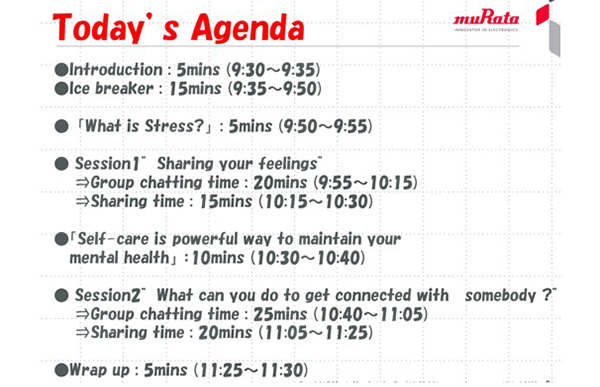 Extract from the document of stress management training for employees dispatched from overseas
Extract from the document of stress management training for employees dispatched from overseas
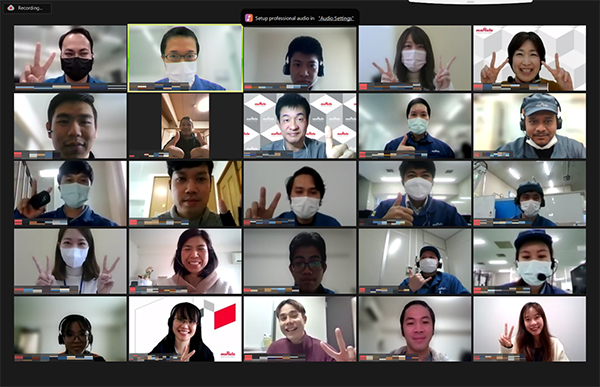 Stress management training for employees dispatched from overseas
Stress management training for employees dispatched from overseas
Improvement of sleep: Initiatives to improve shift workers' ES (employee satisfaction)
In order to improve the ES of shift workers who support Murata's manufacturing sites, we focus on improving the quality of their sleep. We noted that shift workers were seeking advice on sleep problems from the Health Management Office. Conventionally, industrial health professionals provided training on appropriate sleep and gave advice to shift workers. However, such training and advice were no more than general information and advice about sleep and effective countermeasures were not in place. We decided to implement initiatives that suited actual site conditions. Since September 2021, having invited Mr. Kazuhiro Yagita, who is a professor at the Kyoto Prefectural University of Medicine and a specialist of circadian rhythms and internal body clocks, as an advisor on measures for improving sleep, we have been taking various measures described below. In introducing measures, we share information and hold discussions with the labor union that represents employees.
Link: Kyoto Prefectural University of Medicine Prof. Yagita, Biological Clock Expert, Appointed as “Sleep Improvement Policy Advisor”.
1. Introducing a "Sleep Questionnaire" and a "Sleep Diary" in response to employees asking for advice on their sleep conditions
For industrial health professionals to improve their ability to respond, which is required when they are asked by employees for advice about their sleep conditions, we have introduced a "Sleep Questionnaire" for visualizing sleep quality and a "Sleep Diary" for finding out the causes of lack of sleep. These tools can visualize the sleep quality and life rhythm of employees, enabling industrial health professionals to understand the actual conditions and causes of sleep disorder. Information obtained from these tools is utilized along with knowledge about circadian rhythms and internal body clocks, in order to provide employees with more effective advice on their sleep conditions.
2. Creating sleep training content that incorporates insight into circadian rhythms and internal body clocks
We create and develop sleep training content that incorporates insight into circadian rhythms and internal body clocks, for use in training employees and partner company employees. In order to keep internal body clocks and lifestyle rhythms consistent, employees are given advice based on their shift pattern, including the timing in which they are exposed to light, the intensity of light, the timing of meals, what they should eat, and how to spend holidays. In the future, by disseminating this sleep training content to our employees and partner company employees, we aim to create an environment where shift workers can naturally make choices that promote a healthy lifestyle at work.
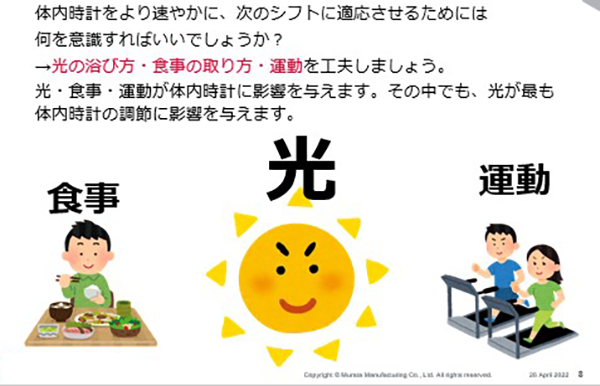 Extract from the document of sleep education contents
Extract from the document of sleep education contents
3. Arranging light environments to support sleep with better quality
Okayama Murata Manufacturing began arranging light environments to help shift workers sleep better. By considering the properties of internal body clocks which are susceptible to light, the company installed high-illumination phototherapy equipment in its manufacturing sites. We verified results* over a trial period lasting roughly two months, and were able to confirm a certain degree of effectiveness. The next step is to take feedback from workers at the site into consideration, and begin renovating all lighting equipment. We will continue to verify results, and will consider expanding this even outside of model processes.
High-illumination phototherapy equipment: Bright light
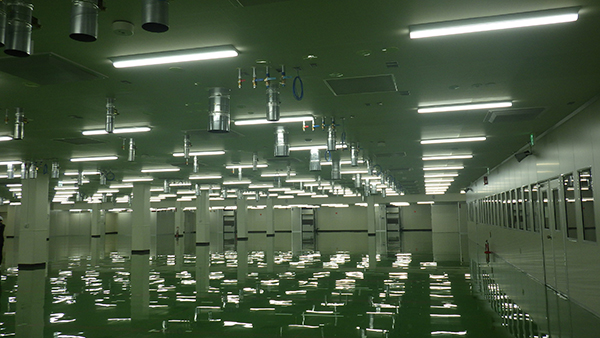 Photo of manufacturing site after changing all lights
Photo of manufacturing site after changing all lights
Through these initiatives for improving employees' sleep quality, we support "the health of employees" that is the basis of ES (employee satisfaction = meaningfulness and development), aiming at creating conditions in which each employee can actively work while feeling they are healthy. We are also working to prevent lifestyle diseases by promoting quality sleep.
-
* The "Fatigue Stress Detector MF100" made by Murata Manufacturing is used to verify results. This product visualizes the degree of "fatigue and stress" which could not easily be evaluated objectively. Based on vital data such as a heart rate and pulse, it highly accurately measures heart rate variabilities and shows the measured data such as the balance of autonomic nerves. Regarding initiatives for sleep improvement, we will obtain data before and after the implementation of the initiatives to clarify the improvement of the employees' physical and mental states. Furthermore, by showing objective data, we will aim at improving the health awareness of employees.
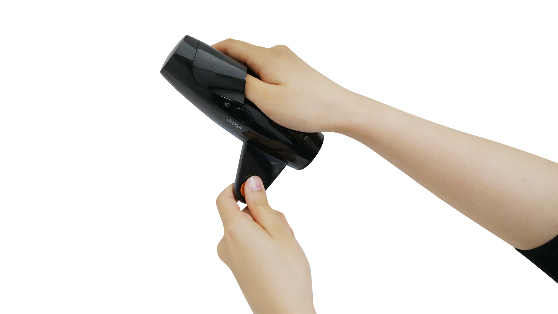 Fatigue Stress Detector MF100
Fatigue Stress Detector MF100
Initiatives to stop smoking
As a health management initiative, we have been promoting countermeasures for smoking since 2018. Through collaborations with the Health Insurance Society, we are expanding the smoking cessation program and are creating an environment to prevent people from breathing in second-hand smoke. In the last few years, we have been taking initiatives such as stopping selling cigarettes in our concession stands and vending machines, hosting health events, implementing counseling for all smokers, posting no smoking posters, and abolishing indoor smoking areas, mainly focusing on "creating an internal environment in which employees do not smoke." On the other hand, we have thought that the essence of the theme lies in "increasing the number of employees who do not smoke," and have changed our approach to measures against smoking since fiscal 2021. With an attitude of "assisting smokers, who want to stop smoking, in stopping it," we provide encouragement by utilizing the nudge theory, cooperate with the Health Insurance Society, and introduce non-smoking programs which utilize ICT.
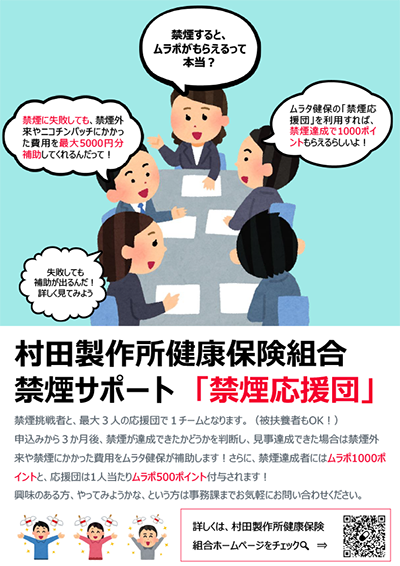 Promotion poster which utilizes the nudge theory
Promotion poster which utilizes the nudge theory
Balanced support system for both cancer treatment and work
Today, cancer is a disease that enables patients to work while they receive treatment at hospitals. However, if going through chemotherapy, patients are required to secure time to receive periodic treatment and it is difficult to continue treatment while working at the same pace prior to receiving treatment. As a measure for these time constraints, we have introduced a support system that balances treatment and work for employees who regularly go to the hospital for cancer treatment while they work. This initiative helped increase inquiries to the Health Management Office from employees who wish to take sick leave. From now on, we will further focus on support that is friendly to employees.
More details on Murata's initiatives can be found on the website of the Ministry of Health, Labour and Welfare.
References
Link: Measures implemented by Murata
Promotion of women's participation in the workplace
In promoting women's participation in the workplace, Murata aims to establish "workplaces that allow anyone regardless of gender to develop their skills through experience, and to engage in dialog and apply themselves diligently." We held "Women's health @Murata," a two-day seminar conducted by industrial physicians, as an opportunity for women, men, and all employees including members of management to consider how to best promote women's participation in the workplace. The seminar covered topics such as the relationship between female hormones and life and career, and information on many actual illnesses and diseases was introduced. A total of 498 individuals participated, and more than 90% of respondents indicated they were "satisfied" with the event on a questionnaire conducted after the seminar. Many participants praised the seminar, with women indicating how reassuring it was hearing some words supporting women, and how unfortunate it was that such a good seminar was only voluntary. Men indicated they were happy to learn more about women's health and to learn the kinds of things they had felt too late to ask. Information from the seminar including materials recorded and distributed during the seminar can also be shared with the families of employees and partner company employees.
We also provide support for women to receive gynecological exams (with a portion of exam fees paid by the Health Insurance Society) to help discover and treat gynecological cancer quickly, in order to further promote women's participation in the workplace and keep women healthy. Gynecological exams are held within the company at the same time as regular medical examinations, in an effort to increase the percentage of women receiving such exams.
We will continue these initiatives and more as we support women's participation in the workplace.
Initiatives based on law
At Murata, we are working to establish workplaces where employees and partner company employees alike are healthy in mind and body, through such measures as conducting regular medical examinations and making use of organizational examinations and workplace feedback based on the stress checks. We continue our efforts to ensure that all employees receive regular medical examinations. For fiscal 2022, 98% of employees received stress checks (10,349 out of 10,559 eligible [single-organization data]).
Chosen as a "Health and Productivity Management Organization (Large Company Division) (White 500)"
Due to our management philosophy, organizations, and initiatives for "health management," Murata has been selected for seven continuous years (from 2017 to 2024) as a "Health and Productivity Management Organization (Large Company Division) (White 500)" by the Ministry of Economy, Trade and Industry and Nippon Kenko Kaigi.
EHS disaster prevention policy of the Murata Manufacturing Group
All organizations in the Murata Manufacturing Group work together to reduce environmental burdens (E), secure health and safety (H & S), and promote disaster prevention activities as part of our management philosophy.
- 1.
We observe laws and regulations as well as terms agreed upon with related organizations.
- 2.
We accomplish this through the following corporate activities listed below.
- 1.
Reducing environmental burdens
- Reducing environmental burdens related to our business
- Preventing environmental pollution
- 2.
Securing health and safety
- Eliminating industrial incidents
- Creating healthy and safe workplaces
- 3.
Promoting disaster prevention initiatives
- Eliminating incidental fire
- Minimizing damage caused by natural disasters
- 3.
Establishing and continually evolving an EHS disaster prevention management system.
- 4.
Communicating our policy to internal and external audiences.
PresidentNorio Nakajima
Murata Health Declaration
In April 2019, Murata announced the “Murata Health Declaration,” which outlines the relationship between the company’s management philosophy and employee health.
Murata understands that health incorporates “safety and security.” Based on this declaration, we defined our EHS ideals and set EHS goals, and are promoting activities that are based on the EHS medium-term and health management plans.
Murata Health Declaration
Murata values the Murata Philosophy, a statement of our corporate principles, and pursues the unique qualities of Murata even under a changing business environment.
We will endeavor to maintain the physical and emotional well-being of employees, who are the foundation of healthy growth, as well as their families so that all employees around the world who share the Murata Philosophy can create innovations and generate new value.
All Murata employees work to their full potential and feel a sense of fulfilment while achieving personal growth and maintaining good physical and emotional health, contributing to Murata's future development as an "Innovator in Electronics."
PresidentNorio Nakajima